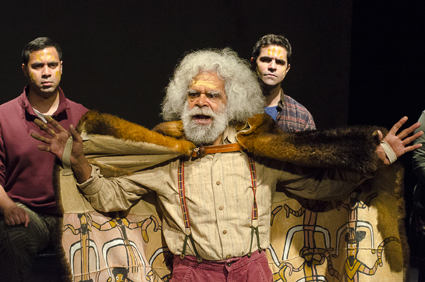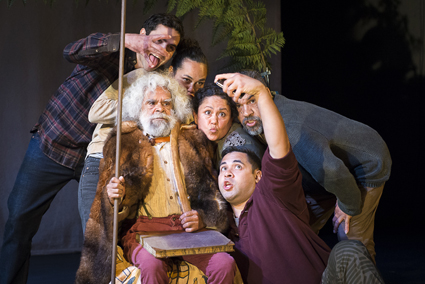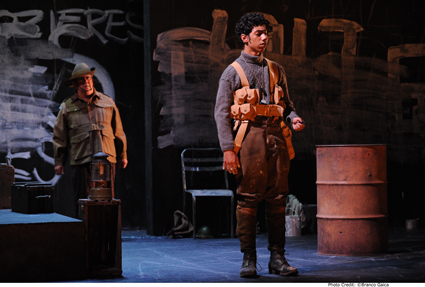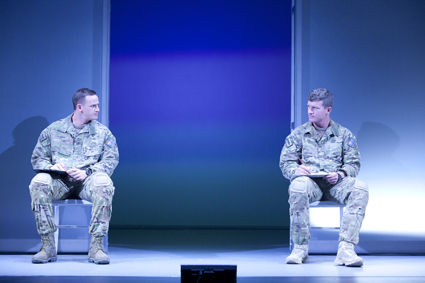For the wounded: theatre & reality
Keith Gallasch: Sydney theatre—Coranderrk, Black Diggers, The Long Way Home

Bjorn Stewart, Jack Charles, Matthew Cooper, Coranderrk, Belvoir & ILBIJERRI Theatre Company
photo Patrick Boland
Bjorn Stewart, Jack Charles, Matthew Cooper, Coranderrk, Belvoir & ILBIJERRI Theatre Company
Documentary theatre—commonly a re-imagining of an era or event using documents, verbatim material and images, an unfolding story and an ensemble of performers often playing multiple roles—has long settled into a standard model. Facticity is its essence while its creativity resides in the dynamics of its editing and the magic of its staging. In the hands of version 1.0 at their best the deployment of contemporary performance strategies has deviated from conventional narrative, making facts, especially in the political sphere, insistently ‘strange’ and all the more evidently lies.
In Belvoir and ILBIJERRI’s Coranderrk and the Queensland Theatre Company and Sydney Festival’s Black Diggers the standard model is still fully operational and, from time to time, emotionally and politically very effective. However, our familiarity with the approach has a distancing effect, and not the one that Brecht had in mind. As a friend said, “Black Diggers was weighed down by its form,” but added, “though it got to me in the end.”
Sydney Theatre Company and the Australian Defence Force’s The Long Way Home, despite eschewing the verbatim theatre model, still inclines to it structurally, least convincingly in a series of short scenes parodying military promotional talks without connection to the work’s theme. But writer Daniel Keene has drawn on his soldier performers’ (and others’) words and lives to provide naturalistic dialogue, more complex characters and longer scenes than one might expect from documentary theatre. Although still short, these at least break the predictable rhythms of the standard model.
In Coranderrk, writer Andrea James has added passages of her own writing to an edited version of the original script by she wrote with Giordano Nanni—which drew directly on the Minutes of Evidence of the 1881 Coranderrk Inquiry. Tom Wright has created dialogue for Black Diggers rich with words once written or recalled: “I thought you fellows could see in the dark?” “I grew up in bloody Erskineville!” These sit side by side with the set pieces you’d expect in this kind of work, like the recurrent speaking aloud of letters—being written or received—and other vignette variations that work cumulatively but are often not long enough to provide emotional depth or complexity.
These three productions have important stories to tell. Two of these have been pretty much forgotten. Coranderrk was an Aboriginal community in 19th century Victoria that for a period was commercially and culturally successful. It was undone by white envy, prejudice and ultimately legislation, Black Diggers portrays the plight of Aboriginal soldiers who fought for the Empire in World War I, side by side with whites, but afterwards once again faced discrimination. The Long Way Home stages the post-traumatic suffering of Australian soldiers who have served in East Timor, Iraq and Afghanistan. We hear about this from time to time in the media but here we have a substantial representation of it.
Coranderrk and Black Diggers stick pretty much to the time frame they’re exploring. Connections with our own time are not made, except implicitly—that white Australians need to know these stories in order to understand their relationship with Aboriginal and Torres Strait Islander Australians. With its costuming, Black Diggers is produced as historical re-creation, 1880-1930s with an ominous set that looks like an enormous World War II bunker, on the walls of which the cast repeatedly paint, and paint over and over, names and battlefield locations.
Coranderrk is likewise limited to its period but has discarded the period costuming of its original production for casual modern dress and added occasional contemporary gestures and references, making it wittier and more assertive. But neither production made a palpable connection with Aboriginal Australia now. Should they, or would that make their didactism too overt?
Catch-up theatre
The ABC television series Redfern Now is firmly focused on the present lives of urban Aboriginals, but such imaginings are not often seen on stage. In RealBlak (RealTime 111,], guest editor and Melbourne-based playwright Jane Harrison interviewed David Milroy, a writer and director with Yirra Yaakin Theatre in Perth, who spoke of the limitations of “catch up theatre” from the 70s—because “we’d been written out of history”—and the autobiographical solo performances (of the 1990s-2000s). “They are very valid,” said Milroy, “but, personally, I don’t do non-fiction shows any more. I am more interested in the craft of fiction…Aboriginal culture isn’t exclusively about ‘catch-up theatre’—having to educate audiences about our history and what really went on in this country. We have so much more to give.”
On seeing Coranderrk—which I enjoyed particularly for those moments when it broke from documentary theatre’s didacticism and opened up to imaginative possibilities—I couldn’t help but feel that an opportunity had been missed, even if had to be a point bluntly made, about the current recolonisation of Aboriginal Australia.
With the advent of The Intervention, ever-expanding mining exploration, limited Indigenous land rights in respect to minerals (outside the Northern Territory) and state policies of “mainstreaming” and “normalisation” (one size individualism and globalisation fits all), it has been argued that the invasion of 1788 has never stopped. “The now dominant view is that Aboriginal culture is the problem…A mythical framework has been developed to offset the naturalised fact of inequality” (Jon Altman & Sean Kerins, People on Country, Vital Landscapes, Vital Futures, The Federation Press, 2012). What happened in Coranderrk is happening still. Land across Australia that was once deemed worthless is now regarded as invaluable for mining, gas, biodiversity and carbon offset.

Coranderrk, Belvoir & ILBIJERRI Theatre Company
photo Patrick Boland
Coranderrk, Belvoir & ILBIJERRI Theatre Company
Ilbijerri and Belvoir, Coranderrk
Its tone at once documentary and poetic, this re-worked production of 2013’s Coranderrk is now textually and visually more tightly focused on and around the Aboriginal elder William Barak. Jack Charles, as Barak, impressively attired in a full-length possum fur cape lined with a cloth reproduction of one of the great man’s paintings (which maintained his people’s culture and were collected by Melbournians) brings the requisite gravitas to his role, quietly intoning the new writing by Andrea James created for this version of Coranderrk, for example:
“With a slow and ancient song, Barak asks permission. His wiry brown fingers clasp the stone axe handle. He chips away at the river bank and slowly and surely…Chip chip chip…the ochre gives way. That piece of beauty now rests in his hand. The soft yellow hue. He spits on the ochre and smears it on his forehead. His song almost finished now, he puts the stone axe back in his belt. Wraps the ochre in his handkerchief and places it into his deep and warm pocket.”
The simple, barely there set comprises a large screen and light stands evoking now and then a Victorian photographic studio and consequently a sense of the era in which Barak lived and of his community. The cast poses in front of projected images of the people whose lives they are portraying—harvesting hops, attired for cricket and school as well as in suits and frocks. It’s an eerily effective device.
The text is taken from a document of the period, delivered by the performers with conversational ease, moments of anger, pain and humour (taking selfies). It reveals white prejudices about race and caste, anxiety over Aboriginal literacy (“then natives will read newspapers!”) and envy of 1st prize agricultural show awards won by Coranderrk and, not least, the growing value of the farming property. The community, made up of members from various clans had claimed and been granted 2,300 acres of land in 1863, subsequently expanding to 4,850 acres and doing very good business selling wheat, vegetables and hops to Melbourne. Coranderrk (a word for the Christmas Bush of the region) at its peak in the 1870s had a schoolhouse, butcher and bakery.
The production briskly tells the story of productive black-white collaboration thwarted by their second manager, a Reverend Strickland under whom residents suffered food, blanket and fuel shortages, received no pay and were subject to whippings. The Coranderrk community fought back vigorously, wrote to journalists, parliamentarians and supporters (like the influential Mrs Ann Bon, who later commissioned a statue of Barak), went on strike and in the winter of 1886, led by Barak and another elder, walked 60km to Melbourne with a petition. As a result, a Royal Commission was held in 1877 and a Parliamentary Inquiry in 1881, in which Aboriginals unprecedentedly appeared as witnesses, but never after. The Aboriginal Protection Board was compelled to properly maintain the reserve.
Tragically, this largely forgotten victory was short-lived. In 1886 the Aboriginal Protection Board, with an Act of Parliament, banished anyone considered half-caste under the age of 35 from Coranderrk, thus radically reducing the work force, diminishing the reserve’s productivity and guaranteeing its decline, as well as breaking up families—portrayed in one of the show’s most bitter and poignant moments.

Black Diggers, Queensland Theatre Company
photo Branco Gaica
Black Diggers, Queensland Theatre Company
QTC and Sydney Festival, Black Diggers
Written by Tom Wright, researched by David Williams and directed by Wesley Enoch, Black Diggers reveals a great deal about the Aboriginal men who enlisted in the Australian army during WWI despite white objections. They served with courage, dignity and camaraderie, felt deeply the separation from family and country and, unlike their white counterparts, were not rewarded plots of land let alone pensions and the vote. The racism that mostly disappeared on the battlefield returned after the war.
Black Diggers features a strong all-male cast in a range of recurring roles depicting a variety of personalities. Its historical scope covers some 50 years, commencing with the full blood/half caste issue critically encountered in Coranderrk and concluding just pre-WWII with Aboriginal soldiers clinging to memories of the war (“Curse war…bless it”) before worse times ensued (depression, alcoholism, poverty); one says of a piece of shell casing: “I held that bit of truth in my hand.” The sense of betrayal by white society is wrenching: no reward or compensation, racist slurs, RSL rejection and jobs lost. At the end the Aboriginal Advancement League is doing its important work in the late 30s while the broken body of a former soldier lies to the side of the stage. Finally an ANZAC Day ceremony (which one Aboriginal soldier has described as the loneliest day of the year) is staged with an actual soldier playing The Last Post. I was astonished that a ceremony representing a major abuse of trust, one that for so long rejected acknowledgement of Aboriginal “defence of our country,” should complete the work, and without an ounce of irony. Perhaps it honoured the soldiers who, despite profound disappointment and bitterness, still stood by their loyalty to Australia. (The play also makes clear that white soldiers for their reward were often given land with poor soil guaranteeing failure, if pushing Aboriginals further off their own land.)
In this kind of work, building a sustained performance is a challenge. Hunter Page-Lochard perhaps fares best playing a young boy whose eagerness to go to war despite his mother’s pleas gets him there. The psychological damage returns him home mute. There are numerous dark moments: what to do for the soul of a dead mate—cut some hair to take home: “That’ll have to do. It’s our fate.” A German doctor working at the science of race measures the physiognomy of a captured Aboriginal soldier. The power of Black Diggers builds through the cumulative power of such scenes and the horrors and occasional joys they entail. We come away certainly better informed and sometimes moved. As with Coranderrk I wondered about now, about Aboriginal and Torres Straits Islanders in our armed forces which are so often beset with bullying and sexism. And racism?

Craig Hancock and Tim Loch, The Long Way Home, Sydney Theatre Company and the Australian Defence Force
photo Lisa Tomasetti
Craig Hancock and Tim Loch, The Long Way Home, Sydney Theatre Company and the Australian Defence Force
STC and ADF: The Long Way Home
The Long Way Home’s evocation of life on the front line, the violence and mind-warping tedium is frightening—explosions, intense flashes of light, picking up the wounded, vast discomforting starry desert nights. The growing emotional gap between wives and their depressed soldier husbands threatens violence and suicide. Past and present—childhood, enlistment, war and aftermath—are woven into portraits of suffering. These are actual soldiers playing variations on themselves with the support of a team of professional actors. Often what is revealed in a scene or on film with them addressing us directly confirms what we learn of them from their program notes, the damage done to minds and bodies, the isolation of recuperation, feelings of guilt or uselessness: “I am my job.” These filmed statements, interpolated into the production once we have become familiar with the faces, lend an air of documentary veracity to the close-to-reality fictions played out between the men on stage.
The stage is constantly populated with heavily armed soldiers on the stage horizon or moving about in cautious lines, always on duty, whether in actuality or as ghosts in the mind of one soldier (Tim Loch) whom they haunt while he seeks refuge in obsessively cleaning his home. A key figure in the play he eventually has the courage to address (“I know you blokes are not fuckin’ real”) and banish them, not that they ever quite disappear, seeks help and is finally reconciled with his wife. He’s the most detailed of the characters. Another soldier (Craig Hancock), even more remote from his wife and suicidal, becomes the first’s friend, easing the way to repaired selves and marriages for both. I did feel that having two not dissimilar couples (although the acting is finely discrete) weakened the play, but it did suggest collective hope. Nor does the play go near the kind of therapy the soldiers receive—it’s just a relief that they’re motivated to get some. The wives’ roles are slender and again similar. I assume there are those who take stronger roles in the recoveries of their partners. Female soldiers (Emma Palmer and Sarah Webster) performed strongly in the production and suffered major wounds and taxing recoveries but we don’t learn just how they made it through. Of course not every story can be told in detail, but the play’s neat symmetries and resolution feel a little too comfortable.
Countering the pervasive sense of on-going trauma there’s plenty of humour—stoic, ironic, bitter. James Whitney’s stumbling attempts to become a stand-up comedian at the Black Dog let loose his guilt about a war-time incident. Another, in a very funny, ‘fuck!’ filled monologue in the Afghanistan desert at night worries that boredom is destroying his mind; another (James Duncan) hallucinates a refrigerator standing in the distance: “Where would they plug it in?” His understanding mate (a perpetually droll Will Bailey) leads him away.
Other comic scenes, like the afore-mentioned public liaison talks, don’t fit the work and should be removed. The enlistment scenes, which reveal three out of four applicants for the army are drongos, are also taxing even if we follow them into the army. Not all the scenes with the children, well acted as they are, connect either, especially a late and too laboured one centred on a dead crow. Of course, as the production is already making its way around the country, revision is unlikely but a 90 minute interval free production would make more sense, and impact.
Very effectively framing the play is a wounded, brain-damaged man whose doctor coldly offers little hope. His muttered words—from the opening of The Odyssey about not being able to save one’s companions—appear line by line on the screen but are not understood by his friends. They are completed at the play’s end when the soldier (Gary Wilson) leaves his bed, walks downstage and speaks to us confidently if with difficulty. The Long Way Home is a fine collaboration between the STC, ADF, Daniel Keene and director Stephen Rayne, one that speaks of a great need, of the kind brought to our attention by Black Diggers, to understand and look after those of whom we ask so much. Of the soldier performers, Tim Loch, Craig Hancock and James Whitney gave performances that suggested total belief in what they were doing on a large stage before a huge audience, with skill and courage. They have given much again, for their comrades.
Belvoir and ILBIJERRI Theatre Company, Coranderrk, writers Andrea James, Giordano Nanni, concept Giordano Nanni, director Isaac Drandic, Belvoir Upstairs, 7 Dec, 2013-3 Jan 2014; Sydney Festival, Black Diggers, writer Tom Wright, director Wesley Enoch, Drama Theatre, Sydney Opera House, Jan 18-26; Sydney Theatre Company and the Australian Defence Force, The Long Way Home, writer Daniel Keene, director Stephen Rayne
RealTime issue #119 Feb-March 2014 pg. 31-33






